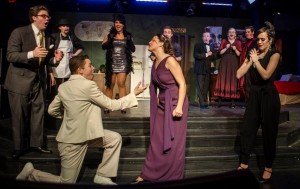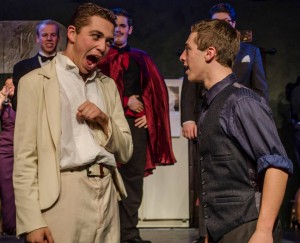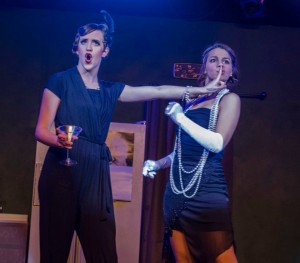By Victoria Espinoza
Special to the Chronicle
Hofstra’s Masquerade performance of “The Drowsy Chaperone: A Musical Within a Comedy” written by Bob Martin and Don McKellar, with lyrics by Lisa Lambert and Greg Morrison, was an uproarious success. The show, which took place Dec. 6-8 at the Spiegel Theater, was co-directed by Chad Hellman and Jack Saleeby, with musical direction by Chad Hellman.
Man in Chair, the lead, was played by a heart-warming and charming freshman, Michael Caizzi. His character opens the play with a dialogue, which makes him appear to be the narrator – but that is a false assumption to make. Man in Chair is sharing his favorite show, “The Drowsy Chaperone” set in the lavish 1920s, with the audience. Quickly, it becomes apparent that he is not the narrator, but rather his mind is the setting in which the story takes place.
Caizzi introduced each character with vivid clarity. First to the stage was Robert Martin (Jack Saleeby) the bridegroom, who was goofy and loveable. His bride, Janet Van de Graff (Deanna Giulietti), showcased many talents throughout her performance. The Drowsy Chaperone (Anna Holmes) had the audience enamored. Holmes brought the character to life with her incredible range of facial expressions.
The plot of “The Drowsy Chaperone” was pointed out by Caizzi quite literally, which is that bad luck ensues when the bride sees the groom on their wedding day.
The ever-so-chatty Man in Chair continues to break the fourth wall throughout the show. In case the plot slips past anyone, Man in Chair pokes fun at the audience by pointing it out after it is blatantly stated.
“I hope you heard that, because that’s the plot the show,” Man in Chair enthuses in a tongue-in-cheek manner.
Before the wedding started to go awry, the show delved further into each character, but that’s not to say the characters became much deeper. Most were presented blandly, almost as flat characters. This went especially for Robert Martin. He was portrayed as a clueless, love-struck man and there the insight ends. Saleeby put on a very impressive display of his tap-dancing skills during the number, “Cold Feets.” Saleeby sang this number charmingly, just as you’d imagine any love-struck man to, along with his character’s best man George (Justin Chesney).
One of the most intricate and entertaining numbers of the show came next, called “Show Off” and centered around Giulietti’s character. Giulietti masterfully conveyed the satirical nature of the song. The humor of the song could have gotten lost in translation by a less talented performer, but Giulietti made it hugely successful. The choreography in this number was also fun to watch, and very well-executed, considering the entire ensemble of 18 cast members danced on the Spiegel Theater’s stage, a rather small venue. The piece was wonderfully choreographed by Joanna Capitelli.
The set design of the show was very well done, and made it easier to understand that “The Drowsy Chaperone” was going on inside Caizzi’s character’s mind. The set on stage was the Man in Chair’s apartment. Characters emerge from his refrigerator or window each time they take the stage to make it known that they are coming from his imagination. Many other clever details also reminded the audience that the show only exists on a record Man in Chair is playing for the audience. During the song “Toledo Surprise,” the record began to skip and the cast sang the same few bars over and over and danced the same few steps on repeat until Caizzi’s character realized his record was faulty.
The ensemble cast did not have a weak actor in the bunch. We were amused by gangsters disguised as pastry chefs, spouting lines like, “You biscotti be kidding me.” We watched a butler, Cameron Draper, endure countless spit takes from his soon to be wife, Gillie Houston. A producer, Andrew Salzano, was amusingly harassed by his ditzy date, Kitty, played by the energetic Alexa Arent.
Yet Caizzi, the lead, was the force to be reckoned with throughout the entire show, whether he was making the audience laugh by dancing in the background of big numbers or making the audience empathize with him when he alluded to the loneliness he lives with every day. “The Drowsy Chaperone” was a truly humorous show from start to finish.
But the magic of the show came from how much this musical meant to Man in Chair.
“It helps you escape from the dreary horrors of the real world,” Man in Chair said during a scene where he was analyzing the musical. Not only is this a poignant line from the show, but it is in essence the transcendent nature of this performance itself.



